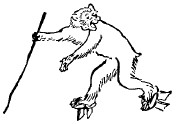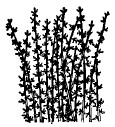| Chapter One |  |
Yi Augury and Your Changing Cycles of Luck
Y OU perhaps have experienced at some juncture in your life that things simply wouldn't go as you wished them to, that every move you made turned out to be exactly the opposite of what you should have done. At such times, your luck was on the wane.
At other times, you may have seen things going exceedingly well, as if all the forces in the universe had been working together to bring you success, giving you the conviction that Fortune was smiling on you. Indeed she was, for your luck was on the rise.
How helpful it would be if you could learn where in this cycle of good and bad luck you now stood. You would then be able to prepare yourself accordingly—to emerge from a period of bad luck with minimum loss, and to maximize your gains in the next lucky period.
This is actually possible. For man, the lord of all creation, has a premonitory instinct, which is present more or less in every individual. At one time or another in your life, you must have experienced a mysterious "hunch" or foreboding of an approaching danger. That was when your premonitory instinct was at work.
Yi augury is a means of utilizing this instinct, and this book tells you how to do it.
There is an old Japanese saying that luck, patience and hard work are the three essentials of success. Persons who are too smart are apt to meet with unexpected failures just because of their smartness, whereas those who are seemingly slow but patient enough to work on like a horse are more likely to find their way to success. But over and beyond these two qualities—persistence and an aptitude for hard work—you need luck.
Some feel that luck tends to concentrate in a handful of people, so that there is not much luck left to go around. They complain that you can wait a thousand years without getting any of it. This is not true.
Luck comes around to all of us, rising and falling in a cycle. The period of each cycle varies from individual to individual. Some have frequent surges of good luck. Others have luck only occasionally, and for a very brief period. Nevertheless, there is a cycle of luck for everyone.
Notwithstanding individual variations, cycles of luck present some general patterns. Specifically, there are three-, seven-, nine-, eleven- and thirteen-year cycles.
Looking back on your past objectively, you will probably find periods of relatively good and relatively poor luck. Sometimes things generally went well, whereas at other times, you were out of Fortune's favor.
Everyone is subject to a cycle of luck, which is controlled by a variety of forces in the universe, including those of celestial bodies and specific moments (which, incidentally, are the basis of horoscopy and the augurial theory about the effect of your age on your luck in a specific year). In other words, you are being carried by the stream of your destiny.
Many people who complain that they have always been unlucky may have overlooked periods of good luck when they did come, not knowing that their luck was on the rise.
Take, for example, the game of poker, in which you often become aware of your cycle of good and bad luck. Success in poker is ascribed seventy percent to luck and thirty percent to the brain, and this predominance of luck is what makes poker a thrilling game of chance. After some training, any poker player with an average brain will be as good as most. A good player is daring when he feels he is lucky, and conservative when he realizes that his luck has taken a turn downward. He thus minimizes his loss and prepares for his next chance, which is bound to come sooner or later. This ability to "wait," knowing when to give up and when to start again, is the most important quality in a successful poker player. Whether in a game or in gambling, the hardest enemy you have to fight is yourself. Indecision, mental instability, impatience—all these must be overcome by sheer will power, and whether you can do that determines your success or failure. A wise gambler always studies his opponent objectively with a cool head, and he can wait with amazing patience. Always being on the offensive does not bring you success. You have to be aggressive at lucky times and patient when you are unlucky if you want to be successful in anything—gambling or business.
Yi augury, using hakke, or eight basic combinations of positive and negative elements, which are common concepts in all ancient Oriental philosophy, allows you to have a glimpse of your own cycle of luck, enabling you to capitalize on your luck when it comes, and warning you when it is declining. It tells you when to stop being aggressive and how long you should wait before luck comes to you again.

What is Yi Augury?
To understand why Yi augury is a reliable means of looking into the future, let us consider its philosophical background in historical perspective.
Its origin may be traced back to chou-yi, a form of augury that evolved about three thousand years ago in China under the Chou dynasty. In those days two methods were in use to divine the future. In one, called pu, tortoise shells and animal bones were burnt and fortunes were told from the cracks they bore. In the other, called shih, grass (medoki) stems were counted. Under the dynasties following Chou, court augurs and private fortunetellers used both methods in combination. At first, pu, relying on burnt cracks, was more authentic; but in time shih with its numerical intricacies became more popular.

In the days of the Han dynasty and thereafter, the Chinese character for yi was understood to mean "changeability" and "ease." Another theory, noting that Yi augury conceived everything in the universe as a combination of two basic elements, positive and negative, claimed that the character yi was made by combining the simpler characters for "sun" and "moon," standing for positive and negative, respectively. Still another theory maintained that it was a hieroglyph representing the lizard.

Today, Yi augury, as developed and handed down by the ancient Chinese sages, combines the positive and negative into eight major combinations called hakke. These combinations of heaven, earth, fire, water, mountain, lake, thunder and wind are further subdivided into the sixty-four minor combinations that appear on the end papers of this volume. Each of the sixty-four minor combinations contains six index variations for a total of 384 combinations. When the ancients broke these down they eventually came up with 11,520 elements representing all things in the universe.
In Chapter Two, four modern methods for arriving at the correct combination which spells out your current and future cycles of luck, are discussed. But no matter if the method used is ancient or modern, all have one common element—all are associated with a faith in mystic numbers.
To represent all 11,520 variations of fate by the use of only sixty-four combinations of elements, ancient fortunetellers gradually came to treat them as symbols. To these was further added the Confucian idea of the "Ten Wings" to complete the present system of Yi augury.
Legend has it that the eight combinations of elements, hakke, were developed by Fu Hsi, the index notes by Wen Wang, and the Ten Wings by Confucius. From Confucius, the system was handed down to Shang Chu, and eventually to Tien Ho, who lived in the days of the Han dynasty. The Book of Changes survived the notorious "burning of books" by the First Emperor of Chin for the reason that it pointed to the right course of action. In the Han period it became increasingly popular until Master Augurs came to hold official positions in the courts of the Emperor Hsuan and the Emperor Yuan in the first century B.C.